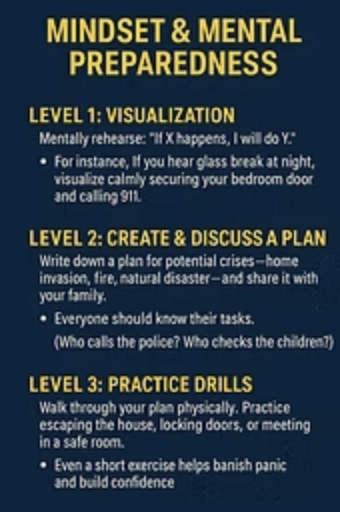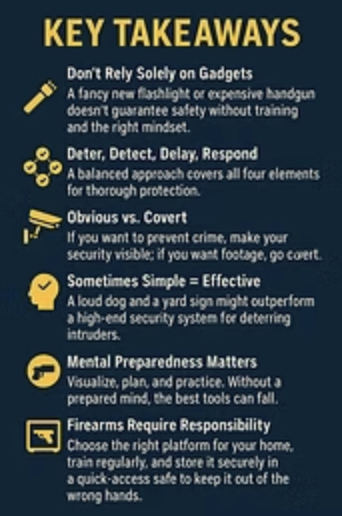Part II: Everyday Home Security: Mindset & Skill Sets
May 2, 2025

In Part I, we focused on the physical layers of home security—how to deter, detect, delay, and respond to threats based on your living environment. But hardware alone isn't enough. In Part II, we turn inward. This section dives into the mindset required for true readiness, the realities of using a firearm for home defense, and why medical training is an essential part of any security plan. Because when the unexpected happens, your ability to think, act, and care under pressure matters more than any gadget.
Mindset & Mental Preparedness
None of the tools or strategies above matter if you're not mentally prepared to use them. At Archangel Readiness Consulting, we teach that mindset is your first and most important line of defense. Here's how we break it down into three simple levels:

Level 1: Visualization
Mentally rehearse: "If X happens, I will do Y."
For example: If you hear glass break at night, picture yourself calmly locking your bedroom door and calling 911.
Level 2: Make a Plan & Talk About It
Write out plans for possible emergencies—home invasions, fires, hurricanes, etc.
Share the plan with your family. Everyone should know their role.
- Who calls 911?
- Who checks on the kids?
- Where do you regroup?
Level 3: Practice It
Walk through your plan like a drill.
Practice locking doors, getting to a safe room, or evacuating the house.
Even five minutes of practice can reduce hesitation and build real confidence.
Responding With a Firearm: Key Considerations
Firearms can be effective tools for home defense—but only when handled responsibly, stored properly, and supported with consistent preparation. Here are a few critical factors to keep in mind:
Choose What You Handle Best
Whether it's a handgun, shotgun, or rifle, your familiarity and confidence with the platform matter more than the brand or price tag.
Consider Over-Penetration & Layout
- Rifle rounds can pass through multiple walls, posing risks to others.
- Shotguns may be difficult to maneuver in tight spaces.
- Handguns are compact but require regular training to remain accurate under stress.
Train Regularly
- Even experienced shooters lose fine motor control under adrenaline.
- Maintain consistent range time and include scenario-based drills when possible.
CPR & First Aid: A Duty to Respond with Care
Neutralizing a threat doesn't mean the emergency is over. You or someone else may be injured—and knowing how to respond with medical care is just as critical as your defensive training.
Essential Skills:
- CPR: Learn how to perform chest compressions and rescue breaths—early intervention is often the difference between life and death.
- Basic First Aid: Know how to control bleeding, treat shock, and stabilize injuries.
Advanced Tools:
- Stop the Bleed Kits: Include tourniquets, gauze, and chest seals.
- AED: If feasible, keep an Automated External Defibrillator at home.
Family Readiness:
- Make sure everyone in the home has basic first aid training.
- Store a complete first-aid kit in a clearly labeled, accessible location.
- Revisit these skills regularly, just like your security drills.
Being prepared means more than being armed—it means being ready to protect and care for those you love in every phase of a crisis.
Key Takeaways for Home Security

-
Don't Rely Solely on Gadgets: A fancy new flashlight or expensive handgun doesn't guarantee safety without training and the right mindset.
-
Deter, Detect, Delay, Respond: A balanced approach covers all four elements for thorough protection.
-
Obvious vs. Covert: If you want to prevent crime, make your security visible; if you want evidence, go covert.
-
Sometimes Simple = Effective: A loud dog and a yard sign might outperform a high-end security system for deterring intruders.
-
Mental Preparedness Matters: Visualize, plan, and practice. Without a prepared mind, the best tools can fail.
-
Firearms Require Responsibility: Choose the right platform for your home, train regularly, and store it securely in a quick-access safe to keep it out of the wrong hands.
-
Medical Skills Save Lives: CPR and first aid are critical parts of true readiness—learn them, teach them, and revisit them often.
Next Steps & Call to Action
True security isn't about the gear you own—it's about the habits you build. Whether you're just getting started or sharpening an existing plan, you don't have to go it alone.
At Archangel Readiness Consulting, we help families and individuals develop practical, personalized security plans that actually work in the real world.
Visit archangelrc.com to explore our services—from home-security audits to hands-on defensive training.
Like this content? Subscribe to our newsletter for real-world tips, case studies, and step-by-step strategies to strengthen your everyday readiness.